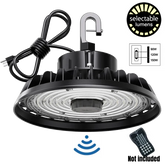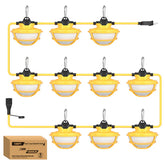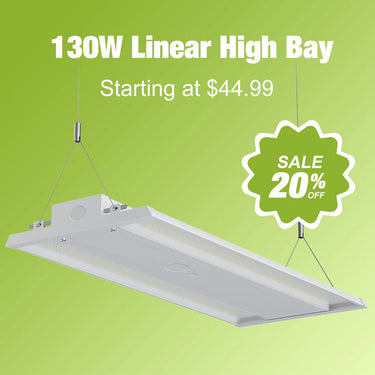How Do High Bay Lights Improve Warehouse Lighting Efficiency?
by
NioJaydon
29 Aug 2025
Warehouses are the backbone of supply chains, where tasks like inventory management, order picking, and equipment operation rely heavily on clear, consistent lighting. Poor lighting not only slows down workflows but also increases the risk of accidents and errors. This is where high bay lights step in—designed specifically for large, high-ceiling spaces (typically 20 feet or taller), they address the unique lighting challenges of warehouses and deliver measurable efficiency gains. Below’s a detailed breakdown of how high bay lights transform warehouse lighting performance.

1. Targeted Brightness That Eliminates Dark Spots
Traditional lighting solutions (such as metal halide or fluorescent fixtures) often struggle to distribute light evenly in tall warehouse spaces. They may produce uneven brightness—creating “hot spots” of overly bright areas and “dark spots” in corners or under shelving—forcing workers to strain their eyes or slow down to avoid mistakes.
High bay lights, by contrast, are engineered with optimized beam angles (ranging from narrow 15° to wide 120°, depending on ceiling height and layout) that direct light precisely where it’s needed. For example:
- Narrow beam angles work for warehouses with very high ceilings (30+ feet) to focus light on specific work zones, like conveyor belts or picking stations.
- Wide beam angles suit mid-height ceilings (20–25 feet) to cover open storage areas without gaps.
This targeted distribution ensures uniform illumination across the entire warehouse floor, eliminating dark spots and reducing eye fatigue. Studies show that consistent lighting can boost picking accuracy by up to 15%—a critical gain for warehouses handling thousands of orders daily.
2. Energy Efficiency That Cuts Operational Costs
Warehouses operate long hours (often 24/7) or extended shifts, making lighting one of their largest energy expenses. Traditional metal halide high bay lights, for instance, waste significant energy as heat—converting only about 20% of energy into light, with 80% lost as thermal output.
Modern LED high bay lights (the most common type used today) reverse this inefficiency:
- They convert 80–90% of energy into light, cutting energy use by 50–70% compared to metal halide or fluorescent fixtures.
-
For a 50,000 sq ft warehouse using 200 100W LED high bay lights (vs. 200 250W metal halide lights), this translates to annual energy savings of ~
0.15/kWh).12,000(basedon
Many high bay lights also integrate motion sensors or dimming controls, which reduce brightness in unoccupied zones (e.g., late-night storage areas) to further lower energy consumption.
3. Long Lifespan Reduces Maintenance Downtime
Maintenance is a hidden cost of warehouse lighting. Traditional fixtures like metal halide bulbs have short lifespans (5,000–10,000 hours) and require frequent replacement—often involving ladders, lifts, or temporary shutdowns of work zones.
LED high bay lights solve this with an average lifespan of 50,000–100,000 hours (equivalent to 5–10 years of continuous use). This means:
- Fewer bulb replacements: A warehouse using LED high bays may only need to replace fixtures once every decade, vs. 5–10 times with metal halide.
- Less downtime: Maintenance teams spend less time disrupting workflows to swap bulbs, and there’s no risk of unexpected outages that slow down picking or shipping.
Additionally, LED high bays have no fragile filaments or glass, making them more resistant to vibration (from forklifts or conveyor belts) and reducing the chance of premature failure.
4. Compatibility With Smart Systems for Dynamic Control
Today’s high bay lights aren’t just “on/off” fixtures—they integrate with smart lighting systems to adapt to warehouse needs in real time, further boosting efficiency.
For example:
- Occupancy sensors: Detect when workers or equipment enter a zone and automatically turn lights on (or brighten them) and off (or dim them) when the zone is empty. This is ideal for large warehouses with variable foot traffic, like seasonal storage areas.
- Daylight harvesting: Use light sensors to adjust artificial light levels based on natural sunlight (e.g., dimming lights near windows on sunny days). This can reduce energy use by an additional 10–20%.
- Remote monitoring: Allow facility managers to track light performance (e.g., energy use, bulb health) via a mobile app or dashboard. They can identify faulty fixtures early, schedule maintenance proactively, and even adjust lighting schedules remotely (e.g., extending brightness for overtime shifts).
These smart features turn static lighting into a dynamic tool that aligns with how the warehouse actually operates, avoiding wasted energy and ensuring optimal brightness when and where it’s needed.
5. Compliance With Safety Standards to Reduce Risks
Efficiency isn’t just about speed or cost—it’s also about keeping workers safe. Poor lighting is a leading cause of warehouse accidents, including slips, trips, falls, and collisions with forklifts or shelving.
High bay lights are designed to meet strict industry safety standards (e.g., OSHA’s minimum illumination requirements for warehouses: 5 foot-candles for general storage, 10 foot-candles for picking zones) by delivering consistent, high-quality light.
Many models also include safety-focused features like:
- Low glare: Diffused lenses reduce harsh glare that can blind workers operating forklifts or scanning barcodes.
- High CRI (Color Rendering Index): A CRI of 80+ ensures colors appear true-to-life, making it easier to distinguish between products (e.g., different box colors) or spot defects in inventory.
By reducing accidents and errors, high bay lights minimize costly downtime (from injuries or rework) and create a more efficient, productive work environment.

High bay lights improve warehouse lighting efficiency not just by being “brighter” than traditional fixtures, but by addressing the unique challenges of tall, large-scale spaces: they deliver uniform light where it’s needed, cut energy costs, reduce maintenance, integrate with smart controls, and keep workers safe. For warehouses looking to streamline operations, lower expenses, and boost productivity, upgrading to high bay lights (especially LED models) is a high-impact investment that pays off in both short-term savings and long-term efficiency gains.
Tags:

















